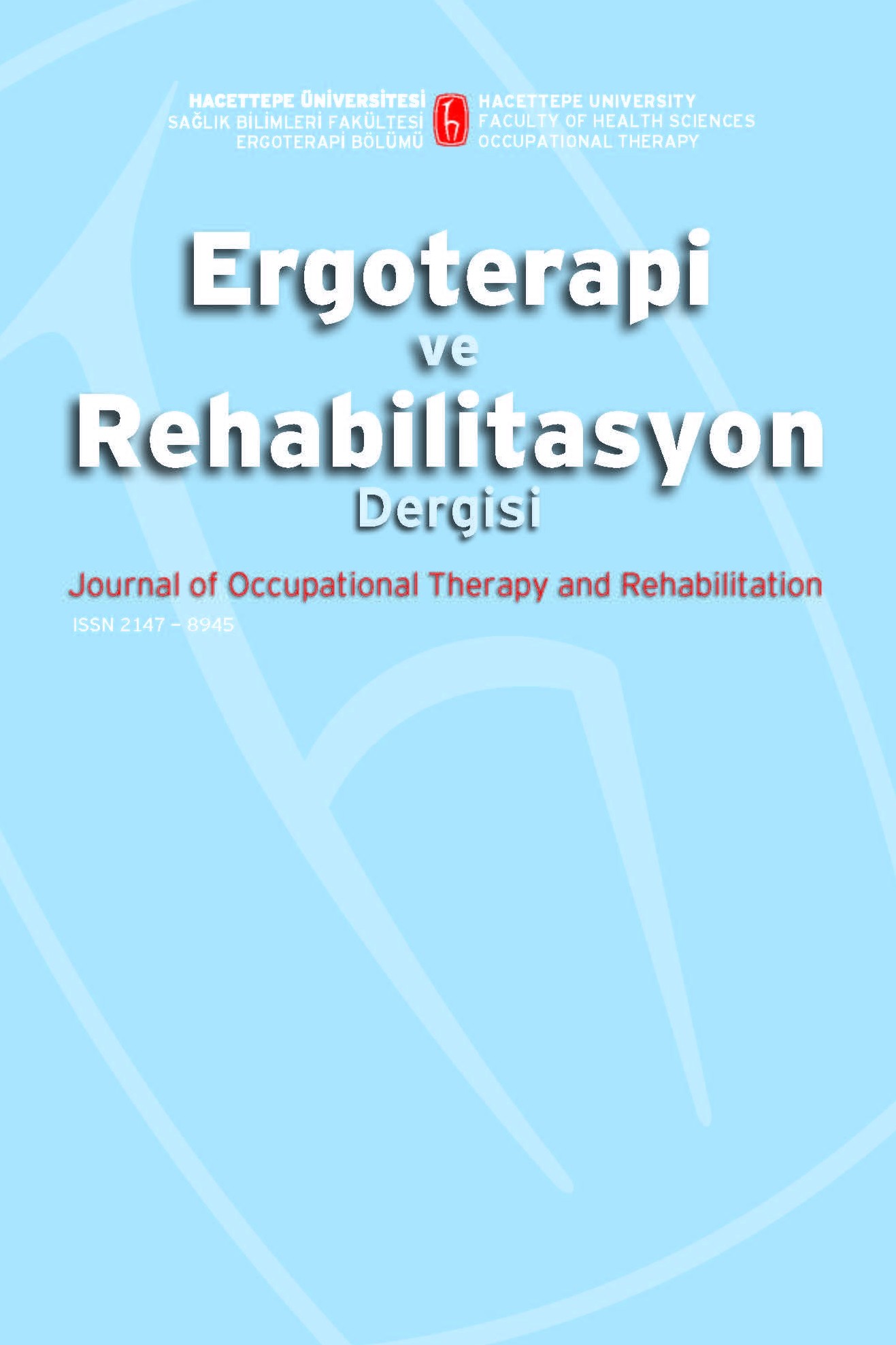Yaygın gelişimsel bozukluğu olan ve normal gelişim gösteren çocukların taktil tercihlerinin karşılaştırılması
Comparison of tactile preferences in children with pervasive developmental disorder and normal developing children
___
- Ayres, A. J. (1972). Types of sensory integrative dysfunction among disabled learners. American Journal of Occupational Therapy.
- Ayres, A. J. (1972). Improving Academic Scoresthrough Sensory Integration. Journal of Learning Disabilities, 5 (6), 338-343.
- Azouz, H. G., Khalil, M., Ghani, H. M. A. E., Hamed, H. M. (2013). Somatosensory evoked potentials in children with autism. Alexandria Journal of Medicine.
- Curry, J., & Exner, C. (1988). Comparison of tactile preferences in children with and without cerebral palsy. The American Journal of Occupational Therapy, 42 (6), 371-377.
- Cascio, C. J. (2010). Somatosensory processing in neurodevelopmental disorders. Journal of neurodevelopmental disorders, 2 (2), 62-69.
- Casenhiser, D. M., Shanker, S. G., & Stieben, J. (2013). Learning through interaction in children with autism: Preliminary data from asocial-communication-based intervention. Autism, 17 (2), 220-241.
- Clayton, K., Fleming, J. M., & Copley, J. (2003). Behavioral responses to tactile stimuli in children with cerebral palsy. Physical & occupational therapy in pediatrics, 23(1), 43-62.
- Engel-Yeger, B., & ziv-On, D. (2011). The relationship between sensory processing difficulties and leisure activity preference of children with different types of ADHD. Research in Developmental Disabilities, 32 (3), 1154-1162.
- Eliasson, A. C., Forssberg, H., Hung, Y. C., & Gordon, A. M. (2006). Development of hand function and precision grip control in individuals with cerebral palsy: a 13- year follow-up study. Pediatrics, 118(4), e1226-e1236.
- Green, S.B., Salkind, N.J., Akey, T.M. (2000). Using SPSS for Windows analayzing and undestanding data. 2nd. Ed.Prentice Hall, New Jersey, 208-232.
- Greenspan, S. I. (1992). Infancy and early childhood: The practice of clinical assessment and intervention with emotional and developmental challenges. International Universities Press, Inc.
- Kientz MA, Dunn W. A (1997). Comparison of the performance of children with and without autism on the Sensory Profile . Am J Occup Ther. 51:530-537.
- Kjellmer, L., Hedvall, Å., Fernell, E., Gillberg, C., & Norrelgen, F. (2012). Language and communication skills in preschool children with autism spectrum disorders: Contribution of cognition, severity of autism symptoms, and adaptive functioning to the variability. Research in developmental disabilities, 33(1), 172-180.
- Meyer, A., & Sagvolden, T. (2006). Fine motor skills in South African children with symptoms of ADHD: influence of subtype, gender, age, and hand dominance. Behavioral and Brain Functions, 2 (1), 33.
- Marco, E. J., Khatibi, K., Hill, S. S., Siegel, B., Arroyo, M. S., Dowling, A. F., Nagarajan, S. S. (2012). Children with autism show reduced somatosensory response: an MEG study. Autism Research, 5 (5), 340-351.
- Molloy CA, Dietrich KN, Bhattacharya A. (2003) Postural stability in children with autism spectrum disorder. J Autism Dev Disord. 33:643-652.
- Pagel, B., Heed, T., & Röder, B. (2009). Change of reference frame for tactile localization during child development. Developmental science, 12 (6), 929-937.
- Pan, N. (2007). Quantification and evaluation of human tactile sense towards fabrics. International Journal of Design and Nature, 1(1), 48-60.
- Parush, S., Sohmer, H., Steinberg, A., Kaitz, M. (2007). Somatosensory function in boys with ADHD and tactile defensiveness. Physiology & Behavior, 90(4), 553-558.
- Provost B, Lopez BR, Heimerl S. (2007). A comparison of motor delays in young children: autism spectrum disorder, developmental delay, and developmental concerns . J Autism Dev Disord ;32:321-328.
- Rogers SJ, Hepburn S, Wehner E. (2003) Parent reports of sensory symptoms in toddlers with autism and those with other developmental disorders . J Autism Dev Disord. 33: 631-642.
- Resnick, S. D., & Nuyens, A. M. (1990). U.S. Patent No. 4,929,211. Washington, DC: U.S. Patent and Trademark Office.Disabilities, 5 (6), 338-343.
- Schultz, A. H. (2013). Some factors ınfluencıng the socıal lıfe of primates ın general and oı early man ın partıcular. Social life of early man, 58.
- Wingert, J. R., Burton, H., Sinclair, R. J., Brunstrom, J. E., & Damiano, D. L. (2008). Tactile sensory abilities in cerebral palsy: deficits in roughness and object discrimination. Developmental Medicine & Child Neurology, 50(11), 832-838.
- Van de Winckel, A., Verheyden, G., Wenderoth, N., Peeters, R., Sunaert, S., Van Hecke, W., ... & Feys, H. (2013). Does somatosensory discrimination activate different brain areas in children with unilateral cerebral palsy compared to typically developing children? An fMRI study. Research in developmental disabilities, 34 (5), 1710-1720.
- zimmer, M., Desch, L., Rosen, L. D., Bailey, M. L., Becker, D., Culbert, T. P., Wiley, S. E. (2012). Sensory integration therapies for children with developmental and behavioral disorders. Pediatrics, 129(6), 1186-1189.
- ISSN: 2147-8945
- Yayın Aralığı: Yılda 3 Sayı
- Başlangıç: 2013
- Yayıncı: Hacettepe Üniversitesi Sağlık Bilimleri Fakültesi
“Normal Şiddet Kavramı Yoktur” Projesi
Yüsra FERLİGÜL, Nergis AVCI, Arif YEŞİLAY, , Bensu SÖĞÜT, Hatice AKBULUT, Meltem MERAN, Semin AKEL, Sinem SALAR
Disiplinlerarası Eğitimin Sağlık ve Sosyal Bakım Çalışanları İçin Önemi
Sezer DOMAÇ, Esra AKI, Mine UYANIK
Sümeyye SEvGİLİ, Esra TuRHAL, Nevin ERGun, Çiğdem ÖKSÜZ
Meral HuRİ, Babak Kashefi MEHR, Onur ALTunTAŞ, Hülya KAyIHAn
Öğrenme Güçlüğü Olan Çocuklarda Duyu Bütünleme Eğitimi’nin Etkinliğinin İncelenmesi
Görme Engelli Öğrencilerde zaman Yönetiminin Aktivite Performansı ve Katılımla İlişkisi
İbrahim Yavuz TATLI, Gamze EKİCİ
Romatoid Artritli Hastaların Eklem ve Enerji Koruma Teknikleri Hakkında Bilgilendirilmesi
Büşra BÜYÜK, Dicle DOĞAN, İrem Duygu ERKAN, Ahmet AYKUT, Vecihe AZİZOĞLU, Şule BAYRAKTAR, Muhlis SÖNMEZ, Elif Nur , KASKIR, Nurten ÇEK, Pırıl KURTDERE, Ömer Faruk İNCE, , Ebru Nur KEMALOĞLU, , Robar ÖZMEN, Robar ÖZMEN, Çiğdem ÖKSÜZ,
Pediatrik Ergoterapistlerin Çalışma Alanları ve Yeterlilikleri
